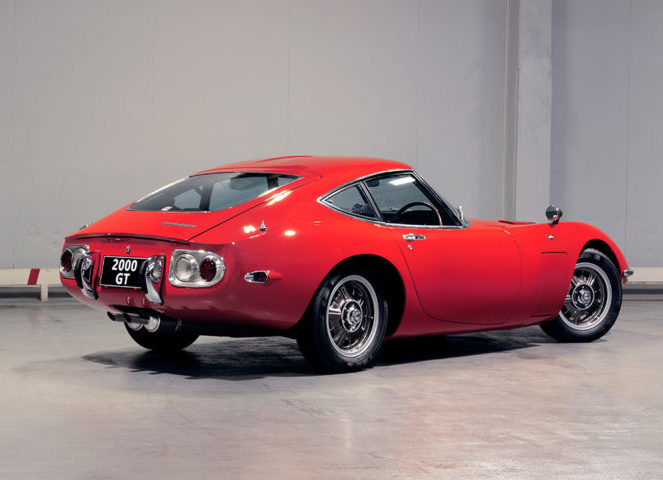
29 Oct Toyota’s Reborn GT
Following WWII, Japan underwent significant changes, the country had to rebuild and many motor manufacturers shifted their focus to building economical cars and utility vehicles. It wasn’t until the first Japanese Grand Prix in 1963 that drivers in the country became interested in performance. Just one year later, Toyota began working on a high-performance model that would showcase the company’s technology and engineering abilities.
The project was headed up by Shoichi Saito, a major contributor to the development of Toyota as a manufacturer. His brief was simple – ‘do whatever is necessary to not only produce the 2000GT but make it one of the – or perhaps even the – greatest car in the world’. The 2000GT would need to be practical yet enjoyable to drive, the engine was to be at the front and driving the rear wheels, finally, it would need to embody a design that would rival those of the more expensive European models.
As a stroke of luck, Yamaha had approached Toyota at roughly the same time with a prototype they had designed. This prototype was originally developed for Nissan, but the rival company rejected the offer for reasons unknown. Toyota, however, approved the design Yamaha submitted and used it to good advantage. Toyota’s designers Jiro Kawano and Satoru Nozaki took the A55X prototype and further developed it into what we know today as the 280 A1 prototype vehicle that was unveiled at the 1965 Tokyo Motor Show. The car was met with great excitement and intrigue, however, buyers would have to wait until 1967 to get their hands on the production version of this new sportscar.
The production version of the 2000GT offers a smooth flowing body which was crafted out of aluminium. It was also the first Japanese car to be fitted with a limited-slip differential and all-round power-assisted disc brakes in standard specification. The 2.0-litre straight-six engine (with its DOHC aluminium head) was developed by Toyota, but subtly fettled by Yamaha. Mated with a five-speed gearbox, the result transcribed to 110 kW and 175 N.m, enough to get the grand tourer from 0-100 km/h in 10 seconds and a top speed of 215 km/h, impressive considering its power output. However, it didn’t fail to impress media the world over…
Road & Track magazine stated that the 2000GT was one of the most exciting cars that they had ever driven and even compared it to the then Porsche 911. But the 2000GT’s most famous moment came when it appeared in the 1967 James Bond movie ‘You Only Live Twice’. Due to Sean Connery’s size and the relatively small cabin, two convertible versions of the 2000GT were specially commissioned for the film. Toyota simply chopped off the roof and replaced it with a soft top unit.
After three short years of production, the last 2000GT left the factory in 1970, which completed the total build cycle of just 351 cars. Produced in such limited numbers, the 2000GT is widely considered to be the ultimate Japanese classic, which is reflected in auctions around the world.
Out of the 351 examples only three were designated for South Africa, and they arrived between 1967 and 1968. Toyota Motors SA has been in possession of one of these examples for many years and recently made the decision to do a full bumper-to-bumper restoration of its 2000GT. The aluminium body was split from the chassis and sent to Dino’s Auto Body for a complete refurbishment, which saw dents being fixed, panels re-aligned and finally, a new layer of Solar Red paint applied. Although only having been driven for just over 30 000 km, the years had taken their toll on this particular example. The paint was clearly in need of work as many scratches, touch-ups and dents littered the body. The sump cover panel and lower valance had been somewhat deformed over the years of bumping into pavements or speed humps. The original wheel design also incorporates spindle ‘knock-on’ locks that were badly beaten up from years of use, but they were carefully refurbished without damaging any of the parts.
One of the last pieces of the puzzle was the windscreen, with international suppliers quoting astronomical figures with no assurance that the part would arrive intact. A local glass manufacturer took on the task and built a bespoke mould then proceeded with no less than six attempts in order to perfect the shape and fitment before the final one popped into place.
On the interior front, the intricacies of the facia made it stressful to remove items in the hopes that none would break. The wood trim for example (which covers the entire centre console), was brittle and faded and is also extremely thin. The chrome detailing cannot be bent when being removed and many of the wires were crumbling at the slightest touch. The wooden steering wheel in particular had a sizeable ‘splinter’, which had to be carefully restored to maintain its structural integrity. The original stereo system was disassembled by a veteran radio repairman, who took on the task of rebuilding the ’60s-vintage electronics and making them functional once more.
Thus the 2000GT’s motor and engine bay were completely stripped and rebuilt. The three 2-barrel Mikuni-Solex 40 PHH Type Q carburettors were stripped down and cleaned, serviced with new seals and gaskets and finally retuned for the best performance. The valve cover was given a new coat of black paint and contrasting red ignition cables were fitted to give the engine that extra touch of character.
Now that the Toyota 2000GT is complete, the company plans to have this rare car on public display, as well as competing in the prestigious South African Concours.
Watch this space…




